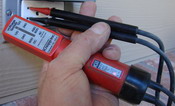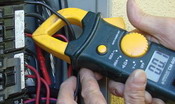» Need Electrical Help? Ask the Electrician
Electrical Testers and Meters
Electricians Tools for Electrical Work
|
|
By Dave Rongey
Summary: Here are the testers and meters I use on most all of my electrical jobs and projects. © By: Dave Rongey |
Digital and Analog Voltage Testers and Multi Meters
Example of Electrical Testers and Meters:
- Inductive Voltage Tester: Check AC or DC Voltage, 120v to 600v range..
- Multi-Function Digital Meter: All in one analog amperage and voltage meter.
- Non-Contact Voltage Tester: Quick test a circuit for voltage.
- Plug-In Circuit Analyzer: Receptacle outlet tester.
- Analog Tester, OHM Resistance Meter: Check AC or DC voltage and resistance.
 |
Inductive Voltage TesterFor testing voltage of wiring and devices 120 to 600 Volts AC DC. I use this type of tester the most, because it produces a quick accurate reading where I can feel the induction coil and see the neon light display. |
 |
Multi-Function Digital MeterClamp-On Amperage Reading, Voltage and Continuity. This is a great all in one meter used for clamp-on amperage readings or a set of test leads for checking voltage or ohms and continuity. |
 |
Non-Contact Voltage TesterThe Non-Conductive Probe Senses Voltage. Non-conductive testers are very handy but are not totally accurate because some may produce false readings so they should not be 100% relied on. |
 |
Plug-In Circuit Analyzer3-Light Display Detects the Wiring Configuration. Plug in circuit analyzers are great but they too are not totally accurate and may produce false readings for boot-legged grounds and neutrals and even reverse polarity. |
Analog Tester, OHM Resistance MeterNon-Conductive Probe Senses Voltage. The good old sweep-needle analog tester has been my buddy for a long time for testing voltage and ohms or continuity for AC and DC circuits. |
|
|||||||
| Electrical Wiring Tools Questions and Answers |
The Safest Way to Test Electrical Devices and Identify Electric Wires!The Non-Contact Electrical TesterThis is a testing tool that I have had in my personal electrical tool pouch for years, and is the first test tool I grab to help identify electrical wiring. It is a Non-contact tester that I use to easily Detect Voltage in Cables, Cords, Circuit Breakers, Lighting Fixtures, Switches, Outlets and Wires. Simply insert the end of the tester into an outlet, lamp socket, or hold the end of the tester against the wire you wish to test. Very handy and easy to use.
The Quickest Way to Check for Faulty Electrical Wiring!The Plug-In Outlet TesterThis is the first tool I grab to troubleshoot a problem with outlet circuit wiring. This popular tester is also used by most inspectors to test for power and check the polarity of circuit wiring. It detects probable improper wiring conditions in standard 110-125 VAC outlets Provides 6 probable wiring conditions that are quick and easy to read for ultimate efficiency Lights indicate if wiring is correct and indicator light chart is included Tests standard 3-wire outlets UL Listed Light indicates if wiring is incorrect Very handy and easy to use.
Strip Off Wire Insulation without Nicking and Damaging the Electric Wire!The Wire Stripper and Wire CutterMy absolute favorite wire stripping tool that I have had in my personal electrical tool pouch for years, and this is the tool I use to safely strip electrical wires. This handy tool has multiple uses: The wire gauges are shown on the side of the tool so you know which slot to use for stripping insulation. The end of the tool can be used to grip and bend wire which is handy for attaching wire onto the screw terminals of switches and outlets.. The wire stripper will work on both solid and stranded wire. This tool is Very Handy and Easy to Use. |
||
Residential Electrical Parts and AccessoriesLight Switches 120volt Outlets Circuit Breakers Electrician Tools Voltage Testers |















